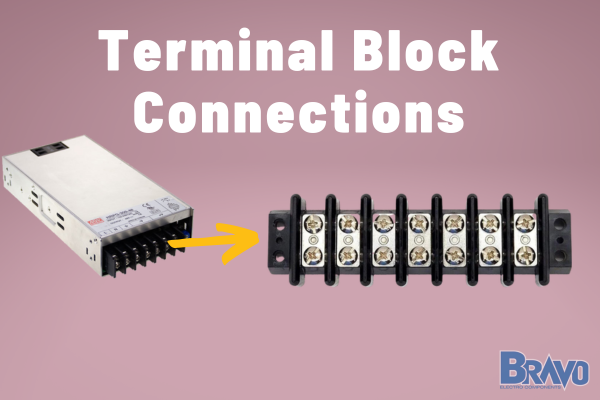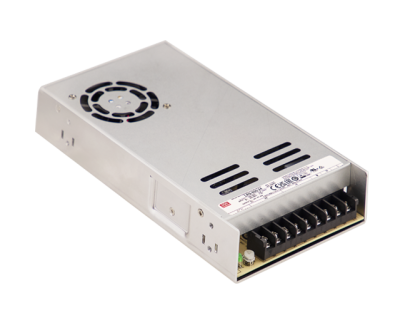
Managing power in an industrial setting can be a daunting task, filled with crucial decisions and meticulous execution. It's a world where precision, safety, and efficiency are paramount.
For professionals navigating this terrain, the topic of connecting a power supply to a terminal block often looms large. A misstep can lead to system failures, dangerous electrical faults, and expensive downtime - scenarios that no professional can afford.
It's clear - confidence in these operations isn't a luxury, but a necessity. That's where we come in. This guide serves as an authoritative resource, engineered to clarify the process of connecting a power supply to a terminal block.
By delving into the very heart of terminal blocks and power supplies, we'll arm you with the knowledge you need to carry out this procedure with precision and peace of mind. Before we teach you how to connect a power supply to a terminal block, though, what exactly are we talking about here?
What are Terminal Blocks for Power Supply?
First, let’s talk about the role terminal blocks play in supplying power to your devices. Below we’ll provide a definition and set the stage for how to connect a power supply to a terminal block.
Terminal Block Definition
Terminal blocks, also known as connection terminals or terminal connectors, are a convenient way to secure and manage wires in a power supply system. They serve as an accessible junction point to connect different components of an electrical system without splicing or physically joining the ends.
Terminal blocks, as part of a power supply, provide a straightforward, organized, and safe way to manage electrical connections. But what exactly do they do?
Do Terminal Blocks Distribute Power?
Yes, terminal blocks play a pivotal role in power distribution.
In a power supply context, they serve as the bridge between the power source and the device. They allow power to be distributed from the power supply to multiple devices in a secure and efficient manner.
This arrangement is particularly useful in complex systems where various devices need power at different voltage levels. That being said, let’s unpack some of the most common types of terminal block connectors.
Types of Terminal Block Connectors
Several types of terminal block connectors are available, each designed to cater to specific requirements. Some common types include:
- Screw Terminal Blocks: These are the most common type, where wires are connected by inserting them into the terminal block and then secured by tightening a screw.
- Spring Terminal Blocks: Also known as spring-clamp terminal blocks, these use a spring mechanism to secure the wires, providing a quick and tool-less connection.
- Barrier Terminal Blocks: These are designed with a protective barrier between each connection point to prevent accidental contact between adjacent wires.
Each type of terminal block connector has its own merits, and the choice depends on the specifics of your application.
Why Proper Terminal Block Connection is So Crucial
Connecting a power supply to a terminal block correctly is crucial to ensure the safe and efficient operation of your system. Improper connections can lead to power disruptions, overheating, compromise the power supply lifespan, or even start electrical fires in severe cases.
Furthermore, a secure and correct terminal block connection helps maintain system performance, prolongs the life of your devices, and upholds the safety standards of your electrical setup.
That being said, whether you’re replacing a power supply or installing new power supply for the first time, learning how to connect a power supply to a terminal block correctly cannot be overlooked. The good news? The experts at Bravo Electro are here to simplify things and guide you through the process below.
How to Connect a Power Supply to a Terminal Block
Delving into the process of connecting a power supply to a terminal block, it's essential to understand the critical differentiation between the input and output sides.
The input side of the terminal block is where the primary power source connects to the power supply. On the other hand, the output side is where the regulated power from the power supply is distributed to the devices in your system.
While the fundamentals of connection are the same for both sides, the input side requires careful attention to input voltage, frequency, and current, as stipulated by the power supply manufacturer. The output side, meanwhile, involves taking into account the voltage requirements of the devices being powered.
With that clear, let's dive into how to actually connect power supplies with terminal blocks connections.
Preparing for the Connection Process
Before you start, make sure you have the necessary tools on hand, such as a wire stripper, a screwdriver (if using a screw terminal block), and the appropriate power supply and terminal block.
Step 1: Ensure Power Supply is Unplugged
Safety should always come first. Ensure the power supply is disconnected or unplugged from the power source before beginning. This step is critical to avoid electrical shock or short circuits.
Step 2: Strip the Wires
With a wire stripper, remove about 1/4 inch to 1/2 inch of the wire's insulation. This process will expose the bare metal conductor needed for the terminal block connection.
Be careful not to strip too much insulation off, as this can expose extra wire, leading to potential short circuits.
Step 3: Identify the Correct Terminal Block Positions
On your terminal block, you'll typically find markings denoting the positive (+) and negative (-) terminals. For AC power supplies, look for 'L' (live) and 'N' (neutral) indicators instead.
Just as with hook up DIN rail power supply, the instructions included with your specific unit are your best friend. Always refer to your power supply’s documentation to ensure correct wire placement.
Step 4: Connect the Wires to the Terminal Block
Insert each wire into the correct terminal block position. For a DC power supply, the red wire typically represents the positive (+) terminal, and the black wire represents the negative (-) terminal.
For AC, the live wire (often brown or red) goes to the 'L' terminal, and the neutral wire (often blue or black) goes to the 'N' terminal.
Step 5: Secure the Wires
If you're using a screw terminal block, tighten the screw over each wire until it's firmly held in place. For spring terminal blocks, the wire will automatically be secured upon insertion.
Remember, the connection should be firm, but be careful not to over-tighten and damage the wire.
Step 6: Double-Check the Connection
Give each wire a gentle tug to ensure it's secure. Verify that each wire is in the correct terminal, there's no exposed wire that could potentially short, and no insulation is caught under the screw or clamp.
Executing these steps with care will establish a robust and reliable connection between your power supply and terminal block, serving as the backbone of your electrical system's efficiency and safety. Still, let’s look at a few common mistakes below and offer solutions for troubleshooting issues.
Common Mistakes and Troubleshooting Terminal Block Connections
Understanding the common mistakes when connecting a power supply to a terminal block can go a long way in preventing problems and ensuring a successful, efficient connection. Here are some tips on trouble shooting power supplies and avoiding these issues.
Incorrect Wire Strip Length
Stripping the correct length of wire is a delicate balance. Too much exposed wire can risk short circuits or electrical arcing, while too little can lead to a weak or intermittent connection.
Ideally, the wire's bare end should reach just to the end of the terminal block without extending beyond it.
Wrong Wire Placement
Incorrectly placed wires can cause a host of issues from inefficient operation to potential damage to your power supply or connected devices.
Always double-check to make sure you've connected the positive and negative wires (or live and neutral wires for AC) to their correct terminals. This step may seem simple, but it is often where mistakes occur.
Loose Connections
A loose connection can lead to increased resistance, heat buildup, and inconsistent power delivery.
This issue is often due to not securing the wire properly within the terminal block or the wire slipping out. If your system experiences unexpected power fluctuations or interruptions, a loose connection could well be the culprit.
Have Questions or Need a Replacement Power Supply? Bravo Electro is Here to Help!
Now you know how to connect a power supply to a terminal block. But if you don’t already have your unit, you may be wondering…what power supply do I need?
Navigating the power supply voltages, power supply efficiency rating, power supply specifications, and various power supply certifications can certainly be overwhelming. But it doesn’t have to be when you enlist the help of Bravo Electro.
Our team of experts is always available to answer any queries you might have, guide you through the connection process, or help troubleshoot any issues. We’re passionate about simplifying power supply for you and helping you keep your operation running smoothly - whether it’s an industrial manufacturing plant or a medical facility.
Beyond our world-class customer service, you can expect to find the perfect unit for your unique needs - sourced from the industry’s most trusted manufacturers. We have a 12v DC power supply, 24v DC power supply, or 48v DC power supply you can count on. And, if these aren’t enough, we even have a selection of high voltage power supplies.
From DIN rail power supplies to enclosed power supplies, open frame power supplies, you name it, we’ve got it. So, reach out today for further guidance on finding the right unit. Because at this point, it’s we wrapped up our guide on how to connect power supplies with terminal blocks connections.
Wrapping Up Our Guide on How to Connect a Power Supply to a Terminal Block
There you have it - how to connect a power supply to a terminal block. While this may seem daunting at first, an understanding of the process, the correct tools, and attention to detail make it a manageable task that ensures the smooth operation of your industrial systems.
Remember that the time invested in getting these connections right will pay dividends in the long run, reducing downtime, preventing damage, and optimizing your system's overall efficiency. We hope this guide has provided valuable insight into achieving these connections right, every time.
And, don’t forget - you can trust Bravo Electro for all your AC DC power supply needs. Whether you’re looking for UL listed power supplies, class ii power supply, modular power supply, or anything in-between.
To learn more about power, explore our blog. We have helpful resources on topics like the difference between AC and DC power, the common signs of power supply failure, how to choose an AC to DC converter, what is a DC-DC converter, and more.
Otherwise, it’s time to find your ideal PSU today at Bravo Electro - or if you already have it, take a crack at connecting power supplies with terminal block connections now that you know how!









